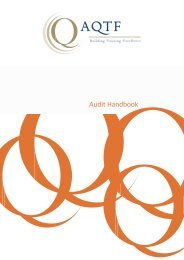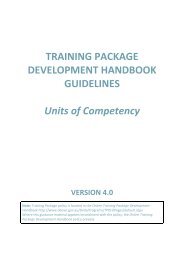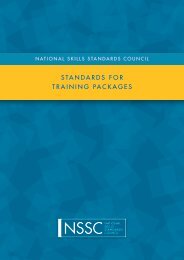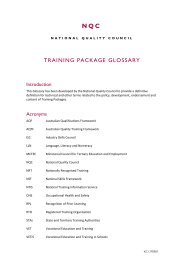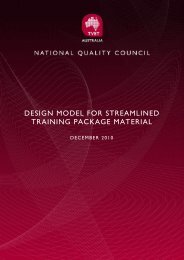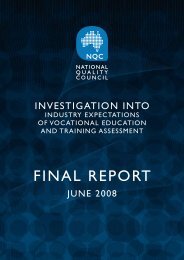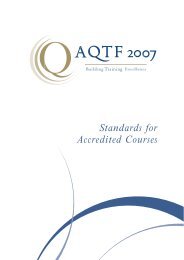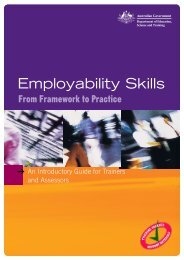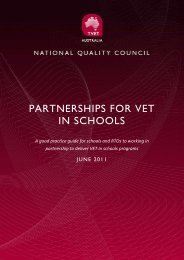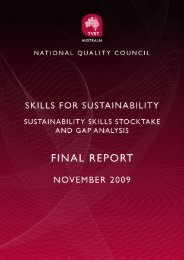VET Products for the 21st Century - National Skills Standards Council
VET Products for the 21st Century - National Skills Standards Council
VET Products for the 21st Century - National Skills Standards Council
Create successful ePaper yourself
Turn your PDF publications into a flip-book with our unique Google optimized e-Paper software.
3 . B a c k g r o u n d a n d c o n t e x t3. Background and contextAt its meeting in March 2008 <strong>the</strong> <strong>Council</strong> ofAustralian Governments (COAG) agreed to a policyframework in <strong>the</strong> areas of skills and work<strong>for</strong>cedevelopment which is designed to boost Australia’sparticipation and productivity. The policyframework identifies four key outcomes:1. The working age population have gaps infoundation skills levels reduced to enableeffective educational, labour market and socialparticipation;2. The working age population has <strong>the</strong> depth andbreadth of skills and capabilities required <strong>for</strong> <strong>the</strong><strong>21st</strong> century labour market;3. The supply of skills provided by <strong>the</strong> nationaltraining system responds to meet changinglabour market demand; and4. <strong>Skills</strong> are used effectively to increase labourmarket efficiency, productivity, innovation, andensure increased utilisation of human capital.To deliver <strong>the</strong>se outcomes <strong>the</strong> vocational educationand training (<strong>VET</strong>) sector needs to engage people,both in and out of <strong>the</strong> work<strong>for</strong>ce, who requirefoundation skills; stimulate demand from individualsand businesses <strong>for</strong> higher level nationallyaccredited training; and enable providers torespond to <strong>the</strong> differing needs of individuals,businesses and industry. The capability andcapacity of <strong>the</strong> <strong>VET</strong> sector is <strong>the</strong>re<strong>for</strong>e critical. Toachieve <strong>the</strong>se outcomes, COAG identified six policyand re<strong>for</strong>m directions:1. Re<strong>for</strong>ming training products, services,in<strong>for</strong>mation systems and regulation to meet amore demand and client driven system;2. Driving fur<strong>the</strong>r competition in current trainingarrangements and streng<strong>the</strong>ning capacity ofproviders and businesses to build <strong>the</strong>foundation and deeper and broader skillsrequired by <strong>the</strong> <strong>21st</strong> century labour market;3. Creating an investment environment andsettings that optimises investment from allsources (governments, individuals, businessesand industry) including funding <strong>for</strong> delivery, taxpolicy, employment programs and incentives;4. Renewal of governance framework to rein<strong>for</strong>ce<strong>the</strong> role of industry and maximise effectivenessand efficiency in intergovernmental relations;5. Ensuring that skills are fully utilised andwastage of human capital is reduced; and6. Identify barriers and implement changes neededin <strong>the</strong> structure and operation of <strong>the</strong> trainingsystem (both nationally and locally) to improvequalification completions and participation inhigher level qualifications by IndigenousAustralians.The JSC recognises that Australia’s <strong>VET</strong> systemhas a role to play in boosting Australia’sparticipation and productivity. In particular, <strong>the</strong> <strong>VET</strong>system will be critical in achieving COAG targetsrelated to an increased:• proportion of <strong>the</strong> working age population at literacy level 1, 2 and 3 (in <strong>the</strong> Adult Literacyand Life <strong>Skills</strong> Survey 4 ); • proportion of 20-64 year olds who have a qualification at or above Certificate III (with a target to halve <strong>the</strong> proportion of 20-64 year olds without qualifications at Certificate III level by 2020, and to double <strong>the</strong> number ofhigher qualification completions by 2020Notably, <strong>the</strong> Commonwealth Government’sresponse to <strong>the</strong> Review of Australian HigherEducation (Bradley Review) sets new targets of (i)40 percent of all 25-34 year olds with a qualificationat bachelor level or above by 2025; and (ii) 20percent of higher education enrolments atundergraduate level should be of people from lowsocio-economic backgrounds by 2020; andexplicitly acknowledges a key role <strong>for</strong> <strong>VET</strong> inachieving <strong>the</strong>se targets. 5The <strong>National</strong> Quality <strong>Council</strong>’s (NQC) 2008 WorkPlan included a project designed to develop policydirections in relation to <strong>the</strong> next generation ofTraining Packages, including a broad consultativeprocess. This project was to build on researchconducted on behalf of <strong>the</strong> NQC in 2007 andadvice provided to MCTVE in 2006 that‘consideration be given to’ ‘providing greaterflexibility and adaptability within <strong>the</strong> next generationof Training Packages’ and ‘building on <strong>the</strong> currentcompetency approach by incorporating <strong>the</strong>development of personal capabilities and attributes(e.g. employability skills) and placing greateremphasis on cognitive ra<strong>the</strong>r than functional(technical) skills’.This project <strong>the</strong>re<strong>for</strong>e represents a convergence of<strong>the</strong> COAG work<strong>for</strong>ce participation and productivityagenda and NQC work to identify improvements toTraining Packages and nationally recognisedvocational education and training (<strong>VET</strong>)qualifications.4Adult Literacy and Life <strong>Skills</strong> Survey, Summary Results,ABS, 20065from <strong>the</strong> Deputy Prime Minister’s speeches of 4, 5, 9 March2009<strong>VET</strong> PRODUCTS FOR THE 21 ST CENTURY - 9



